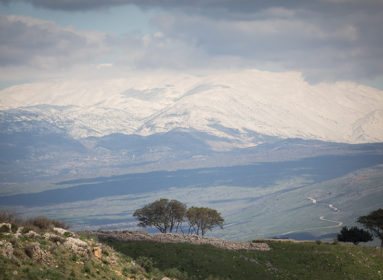Dateline: Washington, D.C.
On March 2 – 4, many rabbis, students and Jewish community leaders from Connecticut were among the 14,000 attendees at the annual American Israel Public Affairs Committee (AIPAC) convention in Washington, D.C. Among them were Rabbi Gary Atkins of Beth Hillel Synagogue in Bloomfield, Elan Ganeles of West Hartford, a senior at the Hebrew High School of New England, and Batsheva Labowe-Stoll, a junior at the Jewish High School of Connecticut, who offered their thoughts on the convention.
From Rabbi Gary Atkins, Beth Hillel Synagogue, Bloomfield
Every year, the first few days in March, AIPAC holds its national convention in Washington, D.C. It’s natural that Washington be the location because AIPAC’s “mission” is lobbying our government on issues affecting the security of Israel.
I am told every year the convention gets larger. This year there were 14,000 attendees. That’s more than attend many football games! This especially cold winter, Washington endured a snow/ice storm that closed down the city on Monday. Many speakers that day joked that attendance was good because there was no other place to go.
But seriously, even if they had been warm, sunny days… the vast majority of delegates were there to learn and express their feelings. There was a plethora of informational sessions, break-out groups, high profile speakers, and many informative vignettes on the wonderful things Israel is doing in technology, medicine, education, and tikkun olam. These positive teachings had two goals; one, to let us know their positive value in and of themselves; and, two, to counter all the negative and even vicious propaganda about Israel that is being spread.

Students from the Jewish High School of CT at the AIPAC Conference: (back row, l to r) Noah Frydman, Shane Rand; (front row, l to r) Batsheva Labowe-Stoll, Talia Weseley, Amber Kitay, Shaina Gluckman and Emma Judd.
Two break-out sessions that I attended, from the dozens to choose from, dealt with (1) ongoing activities within Israel for increasing Israeli Palestinian understanding, and (2) the various anti-missile defense systems that Israel has developed and is continuing to develop. Parenthetically, the recent seizure of a ship with relatively long-range Iranian missiles shows the importance of these continuing improvements.
President Shimon Peres started an NGO 17 years ago to bring businessmen, technocrats and health professionals together to work for a better life for all. Israel is treating in its hospitals thousands of Palestinian children per year and training many Arab doctors. The attitude that Shimon Peres represents is that “optimists and pessimists both die, but optimists live a much better life.” They seek a fairer shared future for all of Israel’s citizens through education. Over 200 people attended this presentation.
The break-out session that I found most fascinating dealt with the generations of anti-missile defense systems that Israel has been developing and continues to develop. As the accuracy and range of Arab missiles increases, it is truly a defense race. Speakers from the Israel Ministry of Defense and Rafael [Israel’s Rafael Advanced Defense Systems Ltd. develops and produces state-of-the-art defense systems for the Israel Defense Forces] showed slides and videos of impressive developments. Watch “Beersheba Missile Attack,” a real-time YouTube video taken at a wedding, showing Iron Dome missiles taking out 14 missiles shot from Gaza in quick succession. The early Patriot missiles did not often destroy enemy warheads; they simply deflected them, which only meant they exploded someplace else. I felt great pride in what the Israeli scientists, perhaps including my own daughter, who works for Rafael, are doing.
From Elan Ganeles, Hebrew High School of New England, West Hartford
This year’s AIPAC Policy Conference was held at the Walter E. Washington Convention Center in Washington D.C., and its main conference hall was filled from end to end with 14,000 supporters of the State of Israel from different walks of life — college and high school students, progressive Democrats, conservatives, human rights workers, political activists, and Jews and Christians from every denomination.
This really taught me a lesson about the influence of community. Standing in one room together, united in support of a strong relationship between the United States and Israel, was one of the most inspirational experiences I have been a part of. At the three-day Policy Conference we heard from an array of speakers, including Senator John McCain, Congressman Eric Cantor, Israeli Prime Minister Benjamin Netanyahu, Senator Robert Menendez, U.S. Secretary of State John Kerry, Israeli entrepreneurs and inventors, AIPAC activists, and many more.
The policy conference also offered many interesting panels led by experts in subjects ranging from terrorism to American policy. I learned about terror network funding, about the consequences of Iran’s nuclear weapons program, and about Iran as the world’s leading state-sponsor of terrorism.
Most importantly, I came away with a sense of how complex the issues are, and how it is not a clear-cut partisan divide. Most U.S. Senators and representatives from both sides of the aisle support Israel, and the Iran sanctions deal is more intricate than many Americans realize.

HHNE students met with Congressman John Larson (D-CT) at the AIPAC Policy Conference. L to r: Elan Ganeles, Akiva Rockland, Congressman John Larson, Senate Page Miriam Young, Ari Zackin, Asher Feigenbaum and Ilan Small.
The culmination of the Policy Conference was our lobbying appointments on Capitol Hill with Congressman John Larson and Senators Richard Blumenthal and Chris Murphy. We even got our very own “VIP tour” — riding from the House side to the Senate side on the underground tram — from Senate Page Miriam Young, a fellow Hebrew High School of New England student.
Delegates from every state in the union met with all 535 U.S. representatives and senators or their staff that day, and the message presented was clear and singular: to strengthen the bonds of friendship between the United States and Israel. Within days, the United States–Israel Strategic Partnership Act, a bill that declares Israel as a major strategic partner of the United States, was signed, and the Cantor-Hoyer letter allowing for greater congressional oversight of the Iran peace talks, garnered many signers.
As participants of the AIPAC Policy Conference and lobbyists, we were able to effect change. This was the first time in my life that I felt a part of something beyond myself. Every person who attended the conference, including me, was essential to the cause.
From Batsheva Labowe-Stoll, Jewish High School of Connecticut, Woodbridge
In early March, students from the Jewish High School of Connecticut had the privilege of attending the AIPAC Policy Conference. Attendees, including me, heard from political leaders including Secretary of State John Kerry, Israeli Prime Minister Benjamin Netanyahu, and Senator John McCain of Arizona. We also heard members of the Latino, African American and Palestinian communities. It was fascinating to hear such inspiring voices from across the political, geographical, and religious spectrum.
Our days consisted of a general session in the morning, two break-out sessions of our choosing, and a general session in the evening. The break-out sessions were especially interesting, because they allowed us to concentrate on a specific topic. For example, a number of sessions featured speakers who addressed the integration of Palestinians into Israeli culture. One Arab-Palestinian discussion leader educates Palestinians to become doctors and teachers in Israel. Such programs encourage civilians to commence the peace process. The concept is to start from the “bottom up” as opposed to enforcing different political policies from the “top down.”
No topic received more attention at the conference than Iran and its nuclear program. Throughout the day AIPAC board members and directors spoke extensively about the Iran nuclear capability plan. Essentially, peace talks have been taking place between Israel, Iran, and the United States. America and Israel have been trying to find a way to convince Iran to stop enriching uranium. However, an end is nowhere in sight. In fact, some suspect that Iran uses peace talks to stall and through the duration of meetings, have continued their program. AIPAC is in the process of lobbying congressmen and urging them not to settle on a bad deal and not to allow Iran to stall the process.
On the last day of the Conference we toured the Capitol building, courtesy of Senator Richard Blumenthal. We saw the entire main structure and the many corridors that congressmen use to maneuver inside the building.







 Southern New England Jewish Ledger
Southern New England Jewish Ledger















